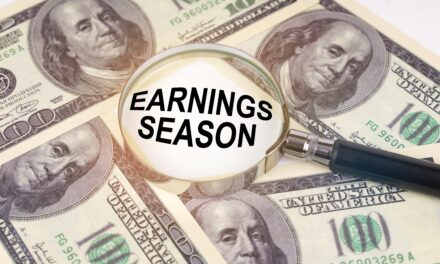Early in April, President Trump shocked the world with his “Liberation Day” announcement of sweeping reciprocal tariffs.
Shortly afterwards, many economists started worrying about an economic phenomenon not seen in nearly half a century:
Stagflation.
Stagflation essentially combines the “worst of both worlds.” You get high unemployment, high inflation, and stagnant economic growth. And today, I’d like to show you why we’re headed towards at least mild stagflation later in the year.
Click on the video below to get started:
Video transcript:
Hi, I’m Andrew Zatlin and welcome to Moneyball Economics.
In fact, today we want to take a look at the latest economic data. We want to understand to what degree it supports the Fed’s fears that we might be heading for stagflation.
Cut to the chase: it’s unclear. I mean, it’s like a Rorschach test. You’re going to see what you want to see in it.
So if you’re a “glass is half empty” economist, yeah, there might be some emerging signs of stagflation. If you’re a “glass is half full” economist, no, those signs aren’t there. And if you’re the Federal Reserve, you’re also not seeing enough clarity to make a decision on interest rates. So you’re probably not going to make a move for a while until the data starts going one way or the other.
Let’s take a look at the data and let’s figure out what it really means…
That means we’re going to look at the latest labor data, the latest consumer spending data and the latest inflation data.
Right off the bat, the labor market seems to be softening. If you’re a glass is half full person, you’d say, yeah, it’s softening, but still within a healthy range, still indicating economic growth. If you’re a half empty person, you can say no. Softening is softening, especially if that’s the trend we’re on. If you’re me, you’re saying, yeah, it’s softening.
So right now, over the past couple of weeks, we’ve seen jobless claims kind of move up and I think they’re going to continue to move up just as we’ve seen payrolls move down and I think they’re going to continue to move down further. And the reason is what I’ve been calling the severance package factor. About 300,000 people have been fired in the past few months, but they haven’t been showing up in the jobless claims or payrolls because most of them got a severance package.
When you’re on a severance package, as long as that severance package lasts, you’re ineligible for unemployment and you’re still included on the payrolls. Well, guess what? I’ve calculated that the end of May and the beginning of June is when most of these severance packages start to disappear. That means all these people are going to be out there filing for jobless claims, unemployment benefits, and they’re going to disappear from the payrolls. So this is a situation where in fact, there is no glass half full. It’s really empty and it’s going to get slower. So if you’re the Fed, you’re going to start to see some slowdown.
Okay, well, let’s talk about another data point that might be a major concern, and that’s retail spending. We just got to look at may retail spending. Retail spending is used as a proxy for the consumer out there, and 70% of our economy is driven by the consumer.
So this tells us whether or not the consumer sentiment is strong, whether that’s translating to actual economic activity, et cetera, et cetera.
Context. This is definitely one of those half full, half empty situations. The made data, the nominal amount of spending is high. In fact, over the past year, it’s one of the highest ever. It’s just a little bit below the past couple of months, and when you look at it again, glass is half full. There are components here that really indicate that the consumer has no problem going out and spending discretionary spending in particular like going out to restaurants and bars.
If you look at the year over year rate of growth going out to restaurants and bars, the consumer is doing great. They’re spending, I think the number was 5.3% in May versus last year. Guess what? That’s fantastic. That’s a lot higher pace of growth, a lot more spending that people are willing to do than practically the last year.
However, again, glass is half empty, would look at that and say, yeah, it’s good, but it’s slower than it was in March and April, so it’s kind of slower. So you see problem is, hey, it’s big, it’s up, but it’s actually kind of coming down a little bit.
My concern isn’t that area. My concern is more what’s going on in another component called building materials. If you are out there and you’re buying a home or you’ve got a home project, it’s going to show up in building materials. It’s also going to show up in furniture. Hey, you’re buying a home, you’ve got to get new furniture or appliances.
Well, guess what? All three of those categories were not looking good. Furniture appliances, kind of flatlining building materials dropped a billion dollars from one month to the next. In fact, building materials in May were the weakest in about a year.
This is not a sign of consumers going out.
These are big ticket items and the consumer is pushing them out, is delaying them. That’s not a good sign. That doesn’t indicate that the consumer is just spending willy-nilly. It actually indicates that they’re saying, “Hey, I’ve got to spend on some things. Home projects not as time sensitive, not as critical to me right now.”
Also, remember, huge chunk of our economy is dependent on construction. So to net it out, spending is looking wobbly. I’m more on the fence saying people are spending whatever paycheck they get, but if wage growth isn’t out there, they’re starting to shift where they’re spending. I’m kind of on the glass is half empty on this one too.
So labor’s slowing down. I’m thinking that consumer spending isn’t going to grow or could possibly slow down. So we’ve got within stag stagflation view, we have a slowing economy in all likelihood.
Now, let’s talk inflation…
We’re standing here and we’re wondering to what degree are tariffs driving up inflation? And the short answer is — nothing as far as we can tell. Slight movement up in producer pricing, and remember, these are the ones who are going to get more immediately affected by any costs that go up.
Producer pricing kind of moved up, but nothing definitive. So again, glass is half empty, glass is half full. If you’re saying glass is half full when it comes to inflation, you’d note again, inflation isn’t moving up, but more critically, as you’ll see from this chart, inflation can only move up when someone has pricing power.
When the internet emerged, I’m going to take you back in time here. I want to give you a framework. When the internet emerged, it did something very, very important. It gave producers visibility to demand and it gave opportunity to adjust their production accordingly so they could see what the real end demand was more in real time and they didn’t overproduce, so we got into a place where there wasn’t as much overproduction or underproduction.
When you have overproduction and underproduction, you get big swings In GDP, you get big swings in inflation. Suddenly the internet destroyed a lot of that inflationary impulse because factories were able to get in line and didn’t really see situations where they suddenly had to ramp up production and they had to pay whatever they had to pay. Demand exceeding supply, classic inflation.
Well, fast forward right now, if you want to know what’s going on out there with factories, you’ll look at manufacturing capacity utilization. What that means is do factories have a lot of vacancy or not? It’s like a hotel. Are the rooms booked in which case I’m going to charge more or do I have a lot of vacancies, in which case I’m scrambling to get people in? It’s that kind of pricing power that factories are looking at.
Well, right now, manufacturing capacity, very tightly connected to inflation and we’re seeing manufacturing capacity utilization start to move up.
That means either demand is moving up and so factories are responding to that demand by producing more, and so the factories are getting used more or it means that supplies are shrinking and so factories have to step in and supply more.
Now, those don’t have to be independent. You could have supplies shrinking because demand is kicked in, but you have to understand we’re in a tariff regime right now, and so we know supplies are starting to shrink and that would explain what’s going on with capacity utilization factors in America.
With all this onshoring and with all this shifting supply chain, they’re getting utilized more. Well, history tells us that if they’re getting utilized more, they’re going to start to have pricing power and that’s going to pull up inflation. It hasn’t happened yet because again, a lot of companies front ran the tariffs, so they are producing more, but they don’t have to raise prices yet. They will, but not yet.
And that, I think, is the biggest fear for the Fed. They’re looking at this and they’re saying at some point in time these higher costs due to tariff imports will start to cascade into the broader economy. We’re just not seeing it yet. So the Fed’s rolling the dice and saying, come back to us, say in July or August, when we look back, we should start to see inflation then history being history, and as a result we are firmly going to see stagflation.
I think that is actually what the data is going to show. Not heavy stagflation, but enough stagflation that’s going to make the fed hesitate to cut rates. Yet we’re going to have to see really deep drops in payrolls, and quite frankly, that is what we’re going to see.
I think by July and August we’re going to start to see payrolls really taking a big hit and the Fed’s going to have to move. They’re going to have to cut interest rates or face worse than just a little bit of a little of inflation. Alright folks, we’re in it to win. Zatlin out.

Andrew Zatlin
Editor, Moneyball Economics





